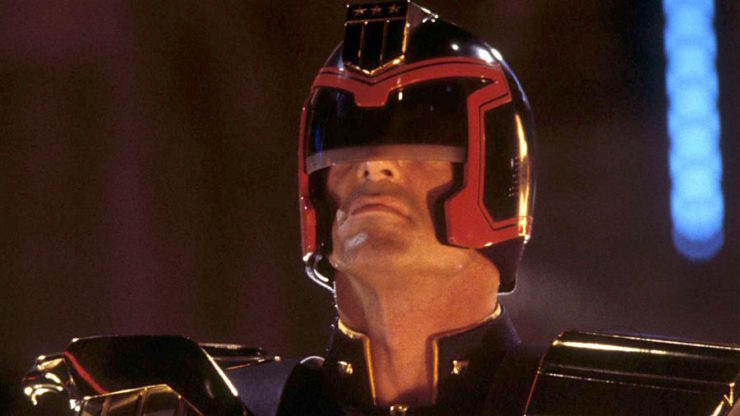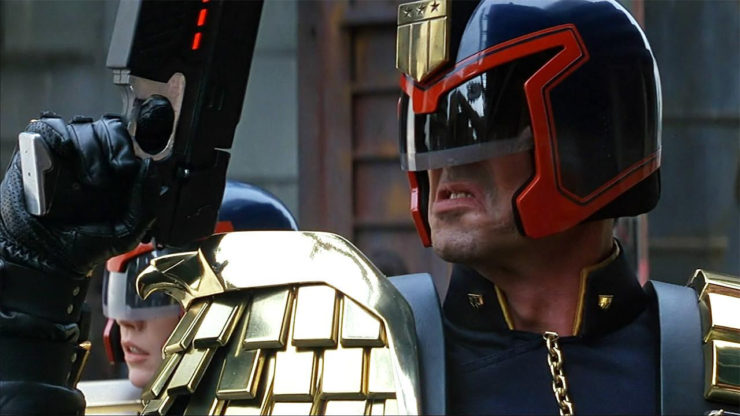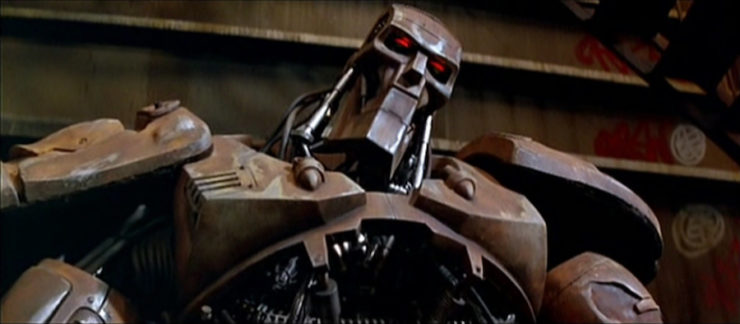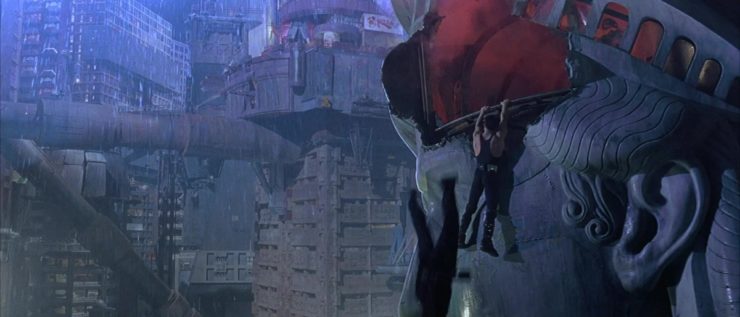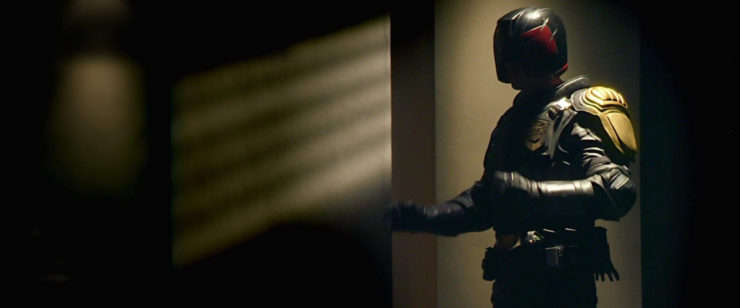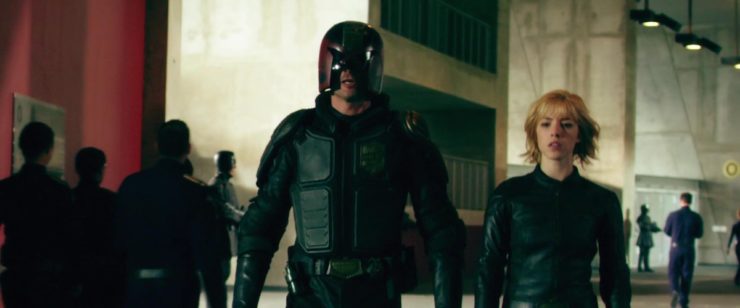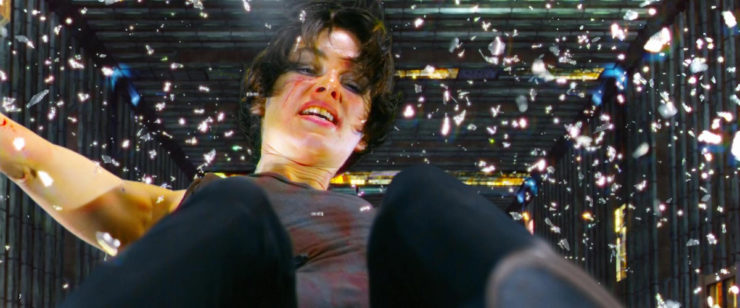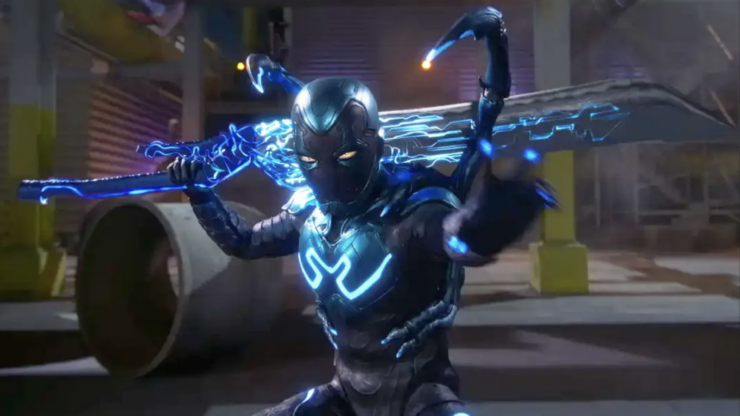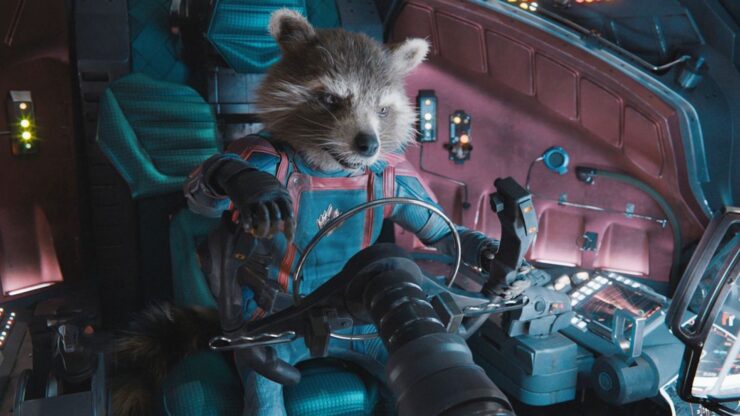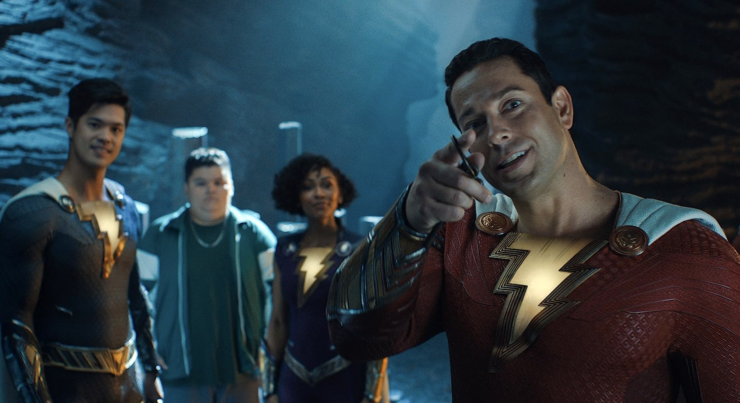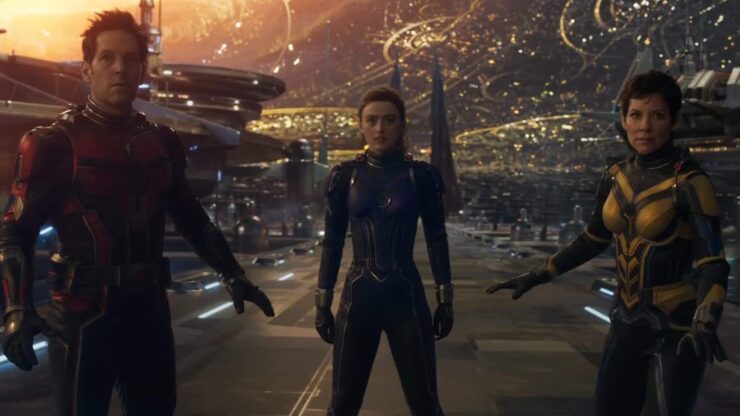Judge Dredd first started appearing in the British comics magazine 2000 A.D. in 1977. That magazine has, over the years, featured work by such British superstar comics creators as Alan Moore, Neil Gaiman, Brian Bolland, Grant Morrison, and Pat Mills and John Wagner. At Mills’s urging (he was editor at the time), Wagner created Dredd, along with artist Carlos Ezquerra, who designed his iconic outfit.
The dystopian future world of Judge Dredd is the most popular feature to come from 2000 A.D., and in 1990 it was spun off into Judge Dredd Megazine, which is still being published today. And twice, Dredd has been adapted into a feature film.
In 1995, Sylvester Stallone starred in Judge Dredd, which seemed a good fit at first, especially since Stallone has the perfect jaw for the role, still identifiable even in Dredd’s big-ass helmet. In the 1990s, Stallone had pretty much finished the Rocky and Rambo series (though he’d come back to both in the 21st century), and he was in search of a good second act. Judge Dredd was in the same throw-it-against-the-wall pile he was doing in the 1990s along with Oscar, Stop or My Mom Will Shoot!, Assassins, Daylight, Demolition Man, The Specialist, Cop Land, and so on. (And yes, some of those were actually decent movies, but I can safely say the only one I remember fondly is Demolition Man.)
Unfortunately, the film was beset with difficulties, mostly the tension between Stallone and director Danny Cannon, as the former saw it as an action-comedy, while the latter viewed it as a dark satire. The film found no audience in the U.S., though it did decently overseas, not aided by the storyline breaking one of the cardinal rules of the comic strip, which is that Dredd’s face is never seen.
By 2012, Stallone’s movie was far enough in the past that another shot could be taken, this time with genre Renaissance man Karl Urban in the role. Urban kept the helmet on throughout the film, which automatically made the movie more favorable to the fans of the comic, while screenwriter Alex Garland turned to the comics for specific inspiration for his screenplay.
However, the 2012 movie also failed to find an audience in theatres, though it has performed better on home video platforms, and there are rumblings of a sequel.
“I knew you were going to say that”
Judge Dredd
Written by Michael De Luca and William Wisher Jr. and Steven E. de Souza
Directed by Danny Cannon
Produced by Charles Lippincott and Beau E.L. Marks
Original release date: June 30, 1995
In the future, much of the planet has been left barely habitable. Most of the population lives in Mega Cities. In Mega City I, which is much of the northeast coast, law is enforced by judges, who serve as cops, prosecutors, and judges all at the same time. One of the finest is Joseph Dredd, who helps Judge Hershey and a rookie judge stop a block war, though the rookie is killed. Dredd is emotionless, interested only in enforcing the law.
After the block war is ended, with all the perpetrators sentenced to death, Dredd arrests Fergie, a thief and hacker who had just been paroled, and was hiding from the block war in a drone. Tampering with the drone while on parole is a five-year jail sentence.
Vartis Hammond is a reporter who is on the verge of exposing corruption among the judges. He and his boss are killed by a judge wearing Dredd’s badge and using Dredd’s gun. (Judges’ weapons have biometrics that enable them only to be used by the judge it’s issued to.)
Dredd is put on trial, with Hershey defending him. The chief justice, Fargo, who is Dredd’s mentor, doesn’t want to believe that Dredd would commit homicide, but the evidence is overwhelming. However, when a judge retires, he goes on “the long walk”—bringing justice to the Cursed Earth outside the city until he or she dies. Traditionally, a judge’s last wish before retiring is always followed, and Fargo decides to retire with his last wish is for Dredd to be judged leniently.
Even as Dredd is sent to life in prison, Fargo leaves the city for his long walk.
However, all of this was part of a cunning plan. The new chief justice, Griffin—the one who recommended that Fargo retire to save Dredd—set this whole thing in motion. Years ago, a judge named Rico went a bit crazy and killed innocents. The incident was covered up and Rico was imprisoned in secret, all records of him wiped from the central computer.
Both Rico and Dredd were clones, created from genetic material from the finest of the judges’ council. The project, codenamed Janus, was abandoned and sealed after Rico went binky-bonkers. Now, though, Griffin wants to revive Janus so he can have perfect judges. He freed Rico from his secret imprisonment, had him impersonate Dredd to kill Hammond (Rico and Dredd have the same DNA), and for shits and giggles, he also got his hands on an old robot enforcer.
At Griffin’s urging, Rico foments more chaos, which should be enough to unseal Janus and allow Griffin to tighten the reins, as it were, with his private army of clones. Rico uses his knowledge of judge procedure and his big-ass robot to kill more than a hundred judges. This massacre, and subsequent rioting, leads the council to unseal Janus so Griffin can re-create it.
The shuttle taking Dredd (and Fergie, who winds up sitting next to him) to prison is shot down by a family of cannibals who live in the Cursed Earth. Dredd and Fergie are captured, but they escape and kill the family—with some help from Fargo, who is fatally stabbed. Before he dies, Fargo tells Dredd about Janus, and says that Rico wasn’t just his best friend, he was his brother.
Dredd and Fergie manage to break back into Mega City. He arrives at the council chambers just in time for Griffin and Rico to assassinate the rest of the council, and Griffin is able to frame Dredd for it. Dredd and Fergie escape to the former’s apartment, which has been trashed—and where Hershey is waiting. The three of them determine that Janus must be housed under the Statue of Liberty because power’s being diverted there. By the time they arrive, Rico’s sudden and inevitable betrayal of Griffin has already happened, and the robot has ripped Griffin’s arms and legs off.
Rico and Dredd face off on top of the Statue of Liberty, Dredd manages to toss Rico off to his doom, saying “Court’s adjourned.” Because of course he did.
The remaining judges want Dredd to be the new chief justice, but he insists on staying a street judge. However, Hershey does kiss him. (Insert Hershey’s kiss joke here.) And then Dredd drives off on his cycle.
“Negotiation’s over. Sentence is death.”
Dredd
Written by Alex Garland
Directed by Pete Travis
Produced by Alex Garland, Andrew Macdonald, and Allon Reich
Original release date: July 11, 2012
Dredd is riding his bike through Mega City, chasing a van that is obviously being driven by someone under the influence. The occupants are taking Slo-Mo, a new narcotic on the streets that makes time go by very slowly. (Why this would appeal to junkies, most of whom want to escape from misery, is an exercise for the viewer, unless there’s a concomitant high, though that’s not at all clear from what we see of the drug.)
Dredd takes down the van, which kills two of the occupants. He chases the third into a food court where he stops the third despite his having taken a hostage.
Reporting back to HQ, the chief judge introduces him to a new recruit named Anderson. She didn’t quite pass at the Academy, falling short by three percent, but she’s a mutant—she was born on the outskirts near the radiation zone—who has psychic abilities. The chief wants Dredd to take her out for a day on the streets, see if her telepathy is enough to make up for that three percent. The chief will hire her or not based on Dredd’s assessment.
Central reports a triple homicide in Peach Trees, a two-hundred-story apartment complex. The three bodies were thrown from the two-hundredth floor after being flensed. They were also high on Slo-Mo when they were tossed, so they got to really savor the experience of falling to their doom.
TJ, the doctor who runs the medical center in Peach Trees, explains to Dredd and Anderson that an ex-hooker named Madeline Madrigal, a.k.a. Ma-Ma, runs all the gangs in Peach Trees, having taken over the four rival gangs that had been running things in the complex. TJ tells them where one of the drug dens is, and the judges raid it. Everyone is killed except for Kay, whom Anderson is fairly certain is the one who killed the three guys. Fairly certain isn’t enough, so Dredd plans to take him in for interrogation.
Ma-Ma doesn’t want Kay interrogated, as he knows too much, so she has her thugs kill the people in the control booth, then has her tech nerd patch into the control room and fool Central into thinking they’re running a drill of their lockdown procedures in case of a war. Blast doors lower, blocking the judges’ comms and trapping them inside. Ma-Ma comes over the PA announcing that there are two judges in Peach Trees and she expects them to be killed.
Dredd and Anderson go on the run, with Kay in tow, taking care of all the thugs who try to stop them. TJ refuses to let them into the medical center. Dredd accuses him of taking sides; TJ says there are no sides, that Dredd’s already dead.
They go to the 76th floor at the urging of a woman who just wants them out before any of the thugs get killed, her husband among them. (Anderson sensibly doesn’t tell her that she already put a bullet in her husband’s head.) Once there, Ma-Ma has her techie trap them, then she shows up with massive cannons and blasts the hell out of the entire floor, killing dozens of citizens. However, the onslaught puts a hole in a blast door, which is enough for Dredd to use an incendiary from his multipurpose weapon to blow a big hole. Once outside, their comms clear and they call for backup.
Unfortunately, they have to go back inside, as they’re sitting ducks on the roof. More unfortunately, the backup that arrives is on the take. Even more unfortunately, Kay manages to get out of his restraints and take Anderson hostage.
Luckily, the corrupt foursome aren’t very good at their jobs. One encounters Dredd and doesn’t ask after Anderson even though two judges called for backup, and only a bad guy would know that Anderson was taken. For her part, Anderson is able to get away when Kay makes the tactical error of trying to kill her with her own weapon, which is attuned to her DNA; when he tries to fire it, it blows his hand off. (Anderson kinda planted that idea in his head when she was doing a deep-dive interrogation of his mind.)
Anderson encounters another judge, but her psychic abilities reveal her intentions, and Anderson shoots her too. The remaining two corner Dredd, and even manage to wound him, but Dredd kills one, and Anderson kills the other before he can kill Dredd. They then proceed to the control room where the techie is willing to give up Ma-Ma’s location (the top floor) and the passcode to get into her stronghold (which Anderson reads psychically). Anderson lets him go free, to Dredd’s annoyance, as he’s guilty, but Anderson also saw in his mind how badly he’d suffered at Ma-Ma’s hands. And she figured she’s already failed her assessment once she got taken hostage, so in for a penny in for a pound.
Ma-Ma hooks up a dead-man switch to her arm. If her heart stops, an explosive will destroy the top floors, and likely the entire complex. Dredd is willing to bet that the signal won’t make it through two hundred floors’ worth of concrete, so he shoots her in the gut, gives her a shot of Slo-Mo, and tosses her over the balcony just like Kay did to the three dudes at the beginning on her order. She dies, the building doesn’t blow up, and the lockdown is released.
Anderson gives Dredd her badge and leaves, but then Dredd tells the chief that she passed.
“This is the law; disperse immediately!”
If you take these two movies and average them out, you get the prefect Judge Dredd movie. Each has significant flaws, and each has elements that are perfect.
Dredd is definitely the better adaptation of the source material. The storyline feels like it was more or less lifted from an issue of 2000 A.D., and Karl Urban always feels like he’s playing the character we’ve seen in the comics for forty years. However, the film doesn’t quite make it in terms of the visuals. Judge Dredd at least looks like a science fiction story. You get the sense that this is a crowded futuristic dystopia, with buildings stacked on buildings and everyone crammed together. Yes, it’s supposed to be a Mega City that stretches from Boston to D.C., but it still should have a crowded feel.
We don’t get that with Dredd, which never manages to feel like it’s the future. There’s nothing in the production design that screams “awful future,” it mostly just screams “contemporary Los Angeles.” Worse, Peach Trees never once feels like it’s two hundred stories tall. The production design and look and feel never quite live up to what the script (or the source material) call for.
However, for all that Judge Dredd looks like the comic, the story is a disaster. While the characters are nominally from the comics, they bear only a passing resemblance to them. The three writers of Judge Dredd took the basic setting for Dredd and slapped a bog-standard action-movie plot on top of it. The whole point of this particular future is that judgment is faceless and emotionless. That’s why we never see the judges’ faces. They’re the embodiment of the law. Having Dredd take off his helmet, and keep it off for 85% of the movie is just a disaster. And yes, it’s a movie, and yes, Stallone’s face is famous, but he was doing just fine at the beginning of the movie.
In fact, the first twenty minutes or so of Judge Dredd is easily the best adaptation of the comic strip ever done. It’s better than Dredd, and it’s way better than the rest of the movie it opens. Those twenty minutes prove that this production team could have done right by Dredd, but chose not to. Instead, we get tiresome character beats, a frame-up followed by a betrayal followed by an unconvincing return to glory, a dopey sidekick (seriously WHO THOUGHT PUTTING ROB SCHNEIDER AS THE GOOFY SIDEKICK IN A JUDGE DREDD MOVIE WAS A GOOD IDEA??????????????), a lame love interest (Diane Lane at least does well with the part of Judge Hershey, though the comic book version would never have kissed Dredd in a billion years), and a raving loony bad guy.
There’s a lot of talent in this movie, and I like that they cast both Max von Sydow and Jurgen Prochnow as supervising judges, so we didn’t know which one of them was the bad guy at first. (But it had to be one of them. I mean, it’s Max von Sydow and Jurgen Prochnow, for crying out loud, neither of these two is likely to play a good guy, and certainly both of them aren’t gonna.) Joan Chen is wasted as a scientist who works with the bad guys, who’s mostly there to give Hershey someone to fight in the climax while Dredd is facing off against Rico. Speaking of Rico, Armand Assante is also wasted in a role that literally anyone who was good at overacting could play.
And then there’s Rob Schneider. Sheesh. Though he does do a good Stallone impersonation at one point, which is also the only actual laugh the character gets.
While the cast is less famous in Dredd—only Urban and Lena Headey are what you’d call names—the casting is much stronger. For one thing, Judge Dredd‘s Mega City is populated entirely by white people, while Dredd remembers that if you shove everyone on the east coast together into one big city, you might actually encounter a person of color or twelve. And even if you’ve never heard of Rakie Ayola, she’s better at playing the chief judge than either von Sydow or Prochnow.
Both movies nailed their lead, at least. Stallone does fine when he’s actually playing Dredd in the first twenty minutes, before it goes from being a Dredd movie to a Generic Stallone Action Movie, and Urban is superb, channeling Clint Eastwood’s Dirty Harry (a major influence on the original comics character) to good effect. And both actors have distinct jaws, which is a vital component of playing the role…
Maybe some day we’ll get the perfect Judge Dredd movie that combines the production values of Judge Dredd with the script sensibilities of Dredd. These two movies’ failures don’t bode well, but then the comic book character’s still going strong after four decades, so who knows what’ll happen in another decade or two?
I know I said I’d do The Mask and Son of the Mask this week, but I was in more of a Dredd mood for whatever reason. We’ll dive into the Tex Avery-esque adaptation of the Dark Horse character next week.
Keith R.A. DeCandido urges folks to check out his Patreon, where you can get cat photos, regular TV and movie reviews, excerpts from his upcoming fiction works, exclusive original vignettes featuring his original characters, and more niftiness.










